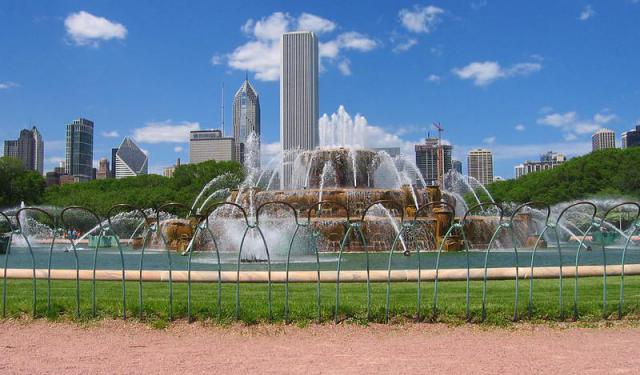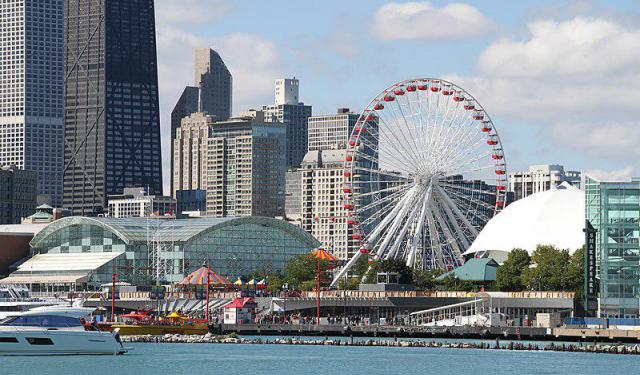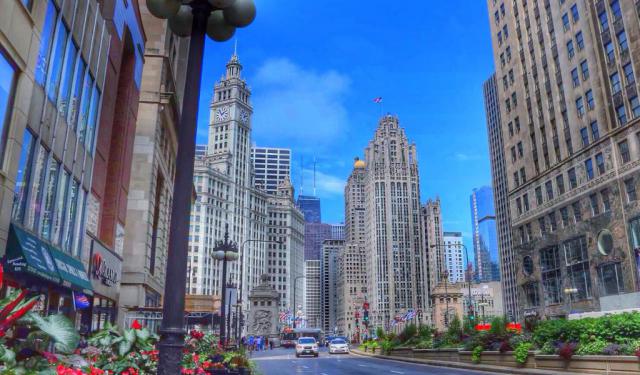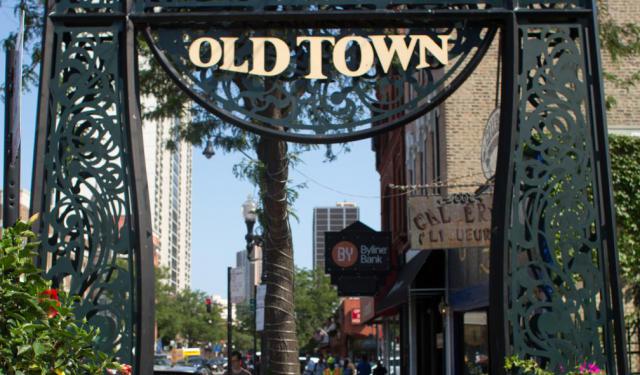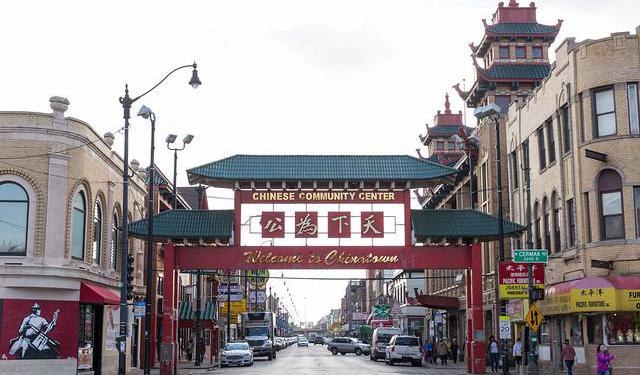Willis Tower - Skydeck Chicago, Chicago (must see)
While London and Paris are recognized respectively for their Big Ben and Eiffel Tower, Chicago has its own architectural landmark that makes its skyline unmistakable for any other place – the Willis Tower. Designed by Skidmore, Owings & Merrill in 1974 and formerly known as the Sears Tower, the building once stood as the tallest skyscraper in the world, until 1996. Recommended by the readers of the Chicago Tribune as one of the "7 wonders of Chicago", this impressive structure rises 1,730 feet tall, spanning 110 stories. While it may have yielded its title and embraced a new name, the fascination of the Skydeck on the 103rd floor remains unmatched. On clear days, it provides breathtaking vistas encompassing the states of Illinois, Michigan, Wisconsin, and Indiana.
The journey in the elevator, lasting a mere 70 seconds, is transformed into an exhilarating experience through video monitors. Within the observatory, interactive exhibits breathe life into Chicago's visionaries, entrepreneurs, architects, musicians, and sports icons. Additionally, computer kiosks, available in six languages, aid international travelers in discovering Chicago's most sought-after destinations. Yet, for many visitors, the ultimate highlight is stepping onto the Ledge, a glass enclosure protruding 4.3 feet from the building, creating the illusion of being suspended 1,353 feet above the ground.
Despite occupying an entire city block and boasting over four million square feet of interior space, the tower was remarkably constructed in just three years. Its innovative design featured nine massive steel "tubes" of varying lengths, bundled together to provide both strength and flexibility. The concept for these distinct levels is said to have originated from the observation of someone shaking cigarettes out of a pack. Initially intended to accommodate up to 13,000 employees of the department store Sears Roebuck & Co., the tower changed hands in 1989 when it was sold to three property developers and is now home to a diverse range of commercial tenants. Remarkably, it houses one hundred elevators and 16,000 windows, all of which are thankfully equipped with automatic window-cleaning systems.
Tip:
Before deciding to ascend, it is advisable to check the visibility ratings, either on your phone or at the security desk. If visibility is less than five miles, it's best to plan your visit for another time.
The journey in the elevator, lasting a mere 70 seconds, is transformed into an exhilarating experience through video monitors. Within the observatory, interactive exhibits breathe life into Chicago's visionaries, entrepreneurs, architects, musicians, and sports icons. Additionally, computer kiosks, available in six languages, aid international travelers in discovering Chicago's most sought-after destinations. Yet, for many visitors, the ultimate highlight is stepping onto the Ledge, a glass enclosure protruding 4.3 feet from the building, creating the illusion of being suspended 1,353 feet above the ground.
Despite occupying an entire city block and boasting over four million square feet of interior space, the tower was remarkably constructed in just three years. Its innovative design featured nine massive steel "tubes" of varying lengths, bundled together to provide both strength and flexibility. The concept for these distinct levels is said to have originated from the observation of someone shaking cigarettes out of a pack. Initially intended to accommodate up to 13,000 employees of the department store Sears Roebuck & Co., the tower changed hands in 1989 when it was sold to three property developers and is now home to a diverse range of commercial tenants. Remarkably, it houses one hundred elevators and 16,000 windows, all of which are thankfully equipped with automatic window-cleaning systems.
Tip:
Before deciding to ascend, it is advisable to check the visibility ratings, either on your phone or at the security desk. If visibility is less than five miles, it's best to plan your visit for another time.
Want to visit this sight? Check out these Self-Guided Walking Tours in Chicago. Alternatively, you can download the mobile app "GPSmyCity: Walks in 1K+ Cities" from Apple App Store or Google Play Store. The app turns your mobile device to a personal tour guide and it works offline, so no data plan is needed when traveling abroad.
Willis Tower - Skydeck Chicago on Map
Sight Name: Willis Tower - Skydeck Chicago
Sight Location: Chicago, USA (See walking tours in Chicago)
Sight Type: Attraction/Landmark
Guide(s) Containing This Sight:
Sight Location: Chicago, USA (See walking tours in Chicago)
Sight Type: Attraction/Landmark
Guide(s) Containing This Sight:
Walking Tours in Chicago, Illinois
Create Your Own Walk in Chicago
Creating your own self-guided walk in Chicago is easy and fun. Choose the city attractions that you want to see and a walk route map will be created just for you. You can even set your hotel as the start point of the walk.
Loop District Architecture Walking Tour
The Chicago Loop District-essentially the city’s historic downtown-has long been a stage for architectural innovation and an open-air museum of American architecture.
The construction boom started after the Great Chicago Fire of 1871, which destroyed much of the central business district, gave architects a blank canvas to rebuild the city from the ground up. What followed was a surge of... view more
Tour Duration: 3 Hour(s)
Travel Distance: 4.7 Km or 2.9 Miles
The construction boom started after the Great Chicago Fire of 1871, which destroyed much of the central business district, gave architects a blank canvas to rebuild the city from the ground up. What followed was a surge of... view more
Tour Duration: 3 Hour(s)
Travel Distance: 4.7 Km or 2.9 Miles
Millennium and Grant Parks Walking Tour
If Chicago had a living room, it would be Grant Park - and if it had a shiny new media room, that would definitely be Millennium Park. These two sprawling green spaces hug the lakeshore like the city’s favorite blanket, offering locals and tourists alike a perfect blend of nature, art, and architecture with a side of skyline.
Let’s start with the elder of the two - Grant Park, established... view more
Tour Duration: 2 Hour(s)
Travel Distance: 2.7 Km or 1.7 Miles
Let’s start with the elder of the two - Grant Park, established... view more
Tour Duration: 2 Hour(s)
Travel Distance: 2.7 Km or 1.7 Miles
Chicago Navy Pier Walking Tour
Additional to scenic views of the lake, the boats, and the city skyline, the Navy Pier offers a variety of attractions on the waterfront – for kids as well as adults – that draw nearly ten million people annually, making this Chicago's most visited spot. Yes, some may see it as a “tourist trap”, but it is worth the time and money to spend some time here, so take this self-guided walk... view more
Tour Duration: 1 Hour(s)
Travel Distance: 1.0 Km or 0.6 Miles
Tour Duration: 1 Hour(s)
Travel Distance: 1.0 Km or 0.6 Miles
The Magnificent Mile Walking Tour
The stretch of Michigan Avenue from the Chicago River to Lake Shore Drive, otherwise known as the Magnificent Mile, is regarded as one of the world’s great avenues – or Chicago’s version of Fifth Avenue. Take this self-guided walk to explore its whole stretch and surrounding area, featuring a wide selection of amazing stores/malls, world-known museums, restaurants and spectacular... view more
Tour Duration: 3 Hour(s)
Travel Distance: 4.0 Km or 2.5 Miles
Tour Duration: 3 Hour(s)
Travel Distance: 4.0 Km or 2.5 Miles
Chicago Old Town Walking Tour
Settled in 1850 by German immigrants, Chicago’s Old Town neighborhood is a popular destination for locals and visitors who cater to the entertainment venues, restaurants, pubs, coffee shops and boutiques – all of which have turned an area once referred to as the “Cabbage Patch” into an attraction that rivals Navy Pier, Wrigley Field and the Magnificent Mile.
Start your Old Town walking... view more
Tour Duration: 2 Hour(s)
Travel Distance: 2.6 Km or 1.6 Miles
Start your Old Town walking... view more
Tour Duration: 2 Hour(s)
Travel Distance: 2.6 Km or 1.6 Miles
Chicago Chinatown Walking Tour
Tucked away just south of the Loop, the Chinatown of Chicago was established in 1912 and is considered one of the best examples of American Chinatown. While it may be one of Chicago’s smallest neighborhoods geographically, it is big on character, colors, sights, sounds, and flavors. Here, you’ll find a wide range of unique boutiques, specialty shops, religious sights, authentic Chinese... view more
Tour Duration: 1 Hour(s)
Travel Distance: 1.7 Km or 1.1 Miles
Tour Duration: 1 Hour(s)
Travel Distance: 1.7 Km or 1.1 Miles
Useful Travel Guides for Planning Your Trip
Chicago Souvenirs: 15 Distinct Local Products to Bring Home
One of the most fascinating cities in the U.S., if not the whole world, Chicago has no shortage of things closely associated with it, often due to their direct origin (blues, gangstership, etc.), so one might literally be spoiled for choice as to what to choose as a "piece" of Chicago to...




